James Francis (Frank) Hurley OBE 1885 - 1962
Antarctic adventurer & photographer
Frank Hurley is recognised as one of Australia's most inspirational photographers, best known for his iconic images of Antarctica and WWI, and for his work as a documentary film maker. Hurley was photographer on the Mawson and Shackleto Antarctic expeditions, an official war photographer in WWI and WWII, and Director of Cinematography at Cinesound Productions. He was awarded an OBE in 1941.
Image: Studio portrait of Captain Frank Hurley c1917. Source: Australian War Memorial P05785.001
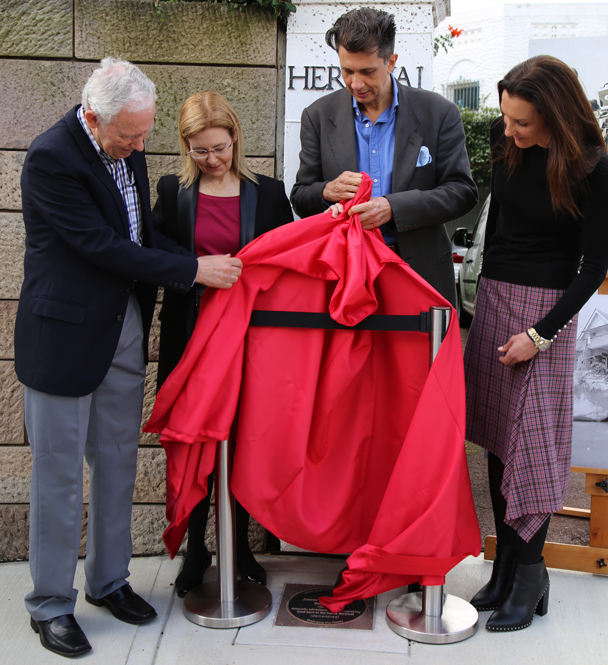
Plaque unveiling 2019 - James Francis (Frank) Hurley - Kevin Mooy, The Hon. Gabrielle Upton MP, Councillor Anthony Marano, Mayor Cllr Susan Wynne.
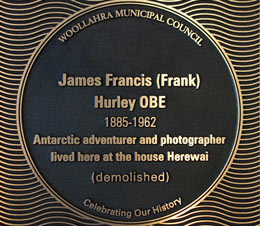
A plaque honouring Frank Hurley OBE, was unveiled on Tuesday 1 October 2019 marking the month Hurley joined Shackleton’s Antarctic expedition in 1914, and close to the anniversary of his birth on 15th October 1885.>
The plaque is located on the footpath outside 55 Wunulla Road, Point Piper, the site of his former home Herewai (now demolished).
Watch the plaque unveiling here
Gallery
James Francis (Frank) Hurley OBE 15 October 1885 - 16 January 1962
Antarctic adventurer and photographer
Family Background
Frank Hurley was born on 15 October 1885 in the Sydney suburb of Glebe. He was the third of five children of Edward Harrison Hurley and his wife Margaret Agnes, née Bouffier. Edward Harrison Hurley arrived in Sydney in the 1860s from Lancaster, England, initially taking up an apprenticeship as a typesetter with John Fairfax & Sons. Edward later made an ultimately unsuccessful attempt at going into business for himself, most likely in the Hunter Valley area, where he met Margaret, who was from the Paterson River area, the daughter of a French vintner. They were married in 1880 – he was 29 and she was 20. Harrison Hurley returned to Sydney to take up a position with the Government Printing Office, settling in Glebe where their son James Francis (Frank) was born in 1885. Harrison Hurley was an active trade union official and secretary of the Printing Trades Federation.
Frank attended Glebe Public School until, at aged 13, he ran away and worked in the Lithgow steel mill, before returning home to Sydney where he was an apprentice electrical fitter and instrument maker in the NSW Telegraphic department. This story appeared in an autobiographical work Argonauts of the South, published in 1925, although there have been some doubts expressed as to the timing of the events as documented in the Argonauts story. It is however known that on his return to Sydney he studied at the Sydney Technical College, gaining several ‘Merits and Awards’.
Commercial photographer
After his return to Sydney, Frank Hurley had developed an interest in photography, and sometime between 1905 and 1907, started work in the studio of Harry Cave, whose business included postcards which were mass-produced during this era.
The high technical quality of Hurley’s work, and the risks he took to photograph unusual subjects resulted in an offer to share in Cave’s business – Hurley’s father provided financial help and ‘Cave & Hurley’ set up in Queens Chambers, Dalley Street, Sydney.
Competition in the industry was tough, and Hurley used a multitude of techniques, in and out of the darkroom, to create memorable images: speeding trains, dramatically lit scenes, and landscape and harbour views. The night image of the Macqaurie Light, South Head, taken in multiple exposures, is one of the memorable images of this period.
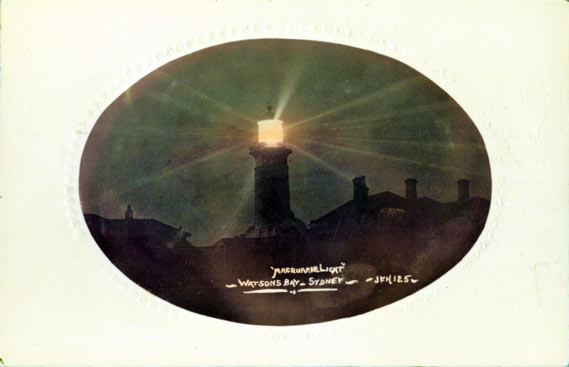
Night view of Macquarie Lighthouse, from a colour post card, photographed by Frank Hurley. Woollahra Libraries Digital Archive pf000685
In 1910 Hurley mounted the first exhibition of his work in Sydney, by which time he had established a good reputation in photographic circles. Frank Hurley’s father had died a few years earlier, and around this time Frank’s business partner Henry Cave retired due to ill health. The postcard trade was waning, and the business was under pressure.
Antarctic Adventurer 1911-1913 and 1914-1916
In 1911, Dr Douglas Mawson revealed his plan for Antarctic exploration to a meeting of the AAASi at the University of Sydney. During the search for candidates for the role of official photographer for the expedition, Hurley was recommended by his friend Henri Mallard, and in September 1911 Hurley wrote formally to Mawson to apply for the position – in spite of an intervention by Hurley’s mother, Mawson offered the job to Hurley in October 1911. Hurley wound down his business obligations in Sydney, and from December 1911 to March 1913 became the photographer and cinematographer of the Mawson Expedition, braving the arduous conditions to capture the landscape and crew members. When he returned to Sydney he assembled his movie footage into a documentary.
Ernest Shackleton, impressed by the documentary after it's showing in England, asked Hurley to film his own expedition across Antarctica, hoping to fund part of the expedition through the sale of photographs and movies. Hurley joined Shackleton’s expedition in October 1914, and it was on this trip that Hurley took some of his most famous photographs of the ship Endurance as it was being slowly destroyed by ice, capturing the harsh conditions endured by Shackleton's men.
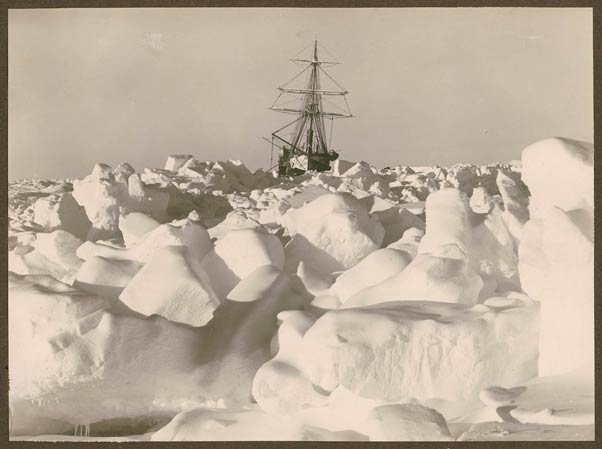
"The Endurance" frozen in, Weddell Sea, January 1915 by Frank Hurley, from Shackleton Expedition photographs 1914-1917 (Imperial Trans-Antarctic Expedition), SLNSW FL957680 ii
Hurley travelled to London at the end of 1916 to assemble his photographic material - the film was released in Australia in 1917 with the title In the Grip of the Polar Ice, subsequently re-released as Endurance in 1933. The film was exhibited in the UK in 1919, with the title South - Ernest Shackleton providing a lecture to accompany the film. View a clip from 'Endurance' here: https://aso.gov.au/titles/documentaries/endurance/clip2/
War Photographer - WWI
In August 1917 Hurley, as honorary captain, joined the Australian Imperial Force as official photographer. Hurley’s photographs of the carnage and destruction of WWI have become some of the most enduring images of the conflict for many Australians.
Hurley, along with Hubert Wilkins, another self-taught photographer, had joined Charles Bean, Australia’s official war historian, to document the Australians at war – whilst each admired the other man’s skills and talents, Bean and Hurley clashed over Hurley’s use of composite images which he felt better reflected reality, but which Bean regarded as fakes. Nevertheless Hurley received a ‘Mention in Dispatches’ in October 1917, for having ‘carried out his work gallantly and conscientiously’. Paul Byrnes, NFSA, wrote that 'both Hurley and Hubert Wilkins were renowned for the risks they took, trying to get footage of exploding shells as they fell. They were nearly killed on several occasions, and became known to some troops as ‘the mad photographers’. In his diary for 26 September, 1917 Hurley wrote:
‘Yesterday we damned near succeeded in having an end made to ourselves. In spite of heavy shelling by the Boche we made an endeavour to secure a number of shell-burst pictures. Many of the shells broke only a few score of paces away, so that we had to throw ourselves into shell holes to avoid splinters … I took two pictures by hiding in a dugout, and then rushing out and snapping. Up went timber, stones, shells and everything else in the vicinity … The frightful concussion absolutely winded us but we escaped injury and made off through mud and water as fast as we possibly could. Egad, I’ve never heard such a row in my life.’
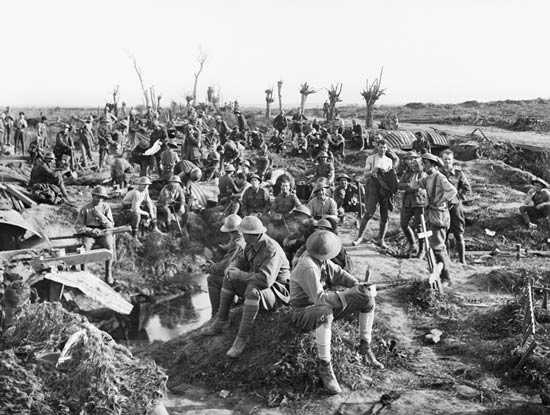
Members of the 14th Battalion, AIF, having a meal near Gordon House, in the Ypres salient, during a brief respite from the fighting, September 1917. Photographer: Frank Hurley. Image and caption: Australian War Memorial E00764.
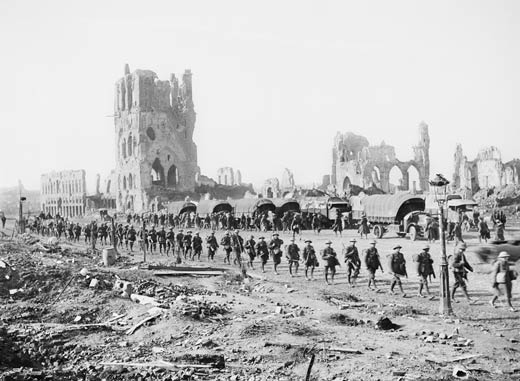
Ypres Sector, Belgium. 25 October 1917. Australians on the way to take up a front line position in the Ypres Sector, Belgium, 25 October 1917. The ruins of Ypres, including the Cloth Hall, can be seen in the background. Photographer: Frank Hurley. Caption and Image: Australian War Memorial E04612
In November 1917, Hurley was ordered to proceed to Egypt. There he met Antoinette Theirault-Leighton, opera singer and daughter of an Indian Army officer, in Cairo - they married after a ten day courtship, on 11 April 1918. On his return to Sydney Hurley arranged exhibitions of his photographs and gave lecture tours with his films which were well received by the public. He later joined the pioneer aviator Ross Smith on the last leg of his historic flight from England to Australia.
Travels to the Torres Strait Islands and Papua
Less known, but equally prolific in terms of the creative output of photographs and film, were the two expeditions Frank Hurley made to the Torres Strait and Papua between December 1920 and January 1923 filming indigenous peoples and making a silent black-and-white film, Pearls and Savages. The film was released in December 1921 with some commercial success. The trip was not without controversy – Hurley clashed with the Papuan administration over alleged improprieties in gathering artefacts for the Australian Museum, Sydney. In 1927, Frank Hurley sold his collection of Papuan images to the Australian Museum, which, along with diaries and films from the expeditions, are said to form an important archive of Papua's history.a
Antarctica 1929
In 1929 Frank Hurley joined the British Australian and New Zealand Antarctic Research Expedition under Mawson's command. He produced two films — Southward ho with Mawson and Siege of the South — which were both shown widely in Australia with accompanying lectures from Hurley in 1930-31. In 1934 was awarded the Polar Medal and two bars and in 1941 was appointed O.B.E.
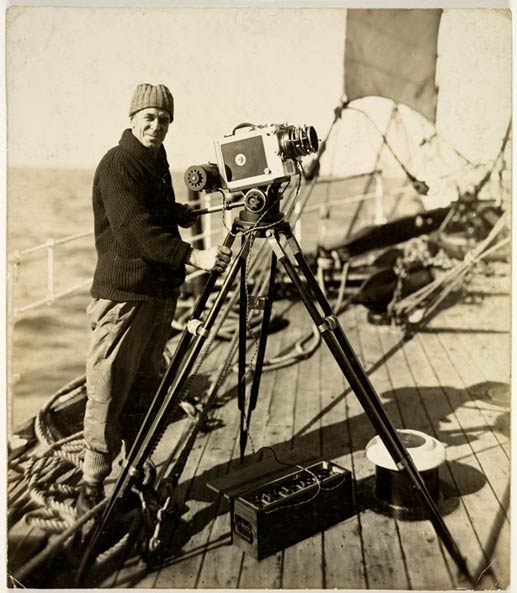
Captain Frank Hurley self-portrait, on board the "Discovery", c1929. British, Australian and New Zealand Antarctic Research Expedition (1929-1931). Mitchell Library, State Library of New South Wales FL3199124
Cinematographer
From 1932, Frank Hurley joined Cinesound Productions as director of cinematography, working on Ken G. Hall’s second feature, The Squatter’s Daughter (1933), ‘a spectacular rural melodrama that also called for a fiery finale. The story of how Hurley and Hall used highly flammable nitrate film to set fire to bushland west of Sydney is part of film industry folklore, but it yielded realistic results'.iii Hurley’s next film for Cinesound was The Silence of Dean Maitland (1934) - one marriage scene was shot at St Michaels Church, Vaucluse. Hurley continued as chief cameraman for the next four years, but became increasingly sidelined after Ken Hall visited Hollywood in late 1935 and sought to introduce an ‘American’ style of cinematography.
View a clip from Hurley's 1938 documentary 'A Nation is Built', a documentary produced by Cinesound for the NSW government to celebrate Australia's sesquicentenary: https://aso.gov.au/titles/documentaries/nation-built/clip1/
WWII Correspondent
With the advent of WWII Hurley was keen to offer his services again. Initially rebuffed by the military, he was appointed by the ABC as a roving correspondent, but did eventually gain a position in the Department of Information Photographic Unit, leaving Sydney again in 1940. For Hurley this was a chance for a final grand adventure.iv He clashed with the younger film makers who found him old-fashioned, and by the end of 1942, the department had decided to bring Hurley home. Hurley however, through his contacts in Britain, was offered a job as Middle East director of Army Features and Propaganda Films with the British Ministry of Information. He did not return to Australia until 1946 – an absence of six years.
Awards
Frank Hurley was awarded the Polar Medal and two bars in 1934 for the 1929-1931 Antarctic Expeditions.vii
In 1941 he was appointed O.B.E.viii
Frank and Antoinette returned to Australian after WWI, settling in Sydney, although Frank was often absent, keeping up his frenetic life of travel and adventure. They had four children – twins Toni and Adeliev (1919), Yvonne (c1921) (the ‘Hurley girlies’) and Frank (1923). During the 1920s, the family lived in a spectacularly sited house Herewai, perched on the rock at the harbours edge in Wunulla Road, Point Piper, in the Woollahra municipality.
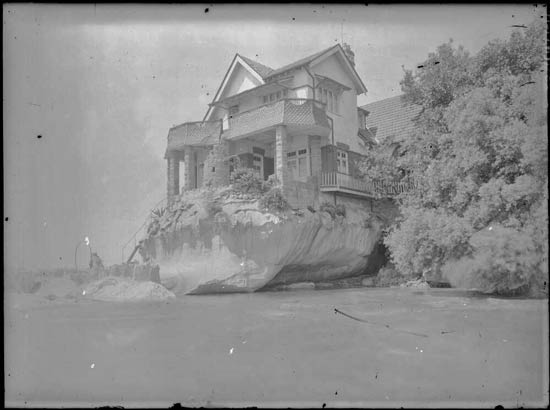
Frank Hurley's house 'Herewai’, 55 Wunulla Road, Point Piper, c1928. Image: National Library of Australia Frank Hurley collection.
In May 1927 the evening programme of Sydney radio station 2FC, which had commenced service in 1924, was broadcast from Captain Frank Hurley's home 'on the edge of Point Piper'.
Captain Hurley led us through the house showing trophies collected in Australia, on the battle fronts, in New Guinea, in the South Seas. He told stories of his wonderfully adventurous life. Everything that was said was broadcast by station 2FC …
The captain showed up his curios from Papua - the big -war drums, the clam shells, the pieces of coral. He banged out tunes on the drums, and one of the guests played on the dulcitone three or four delightful melodies of New Guinea music. Captain Hurley explained that he had recorded these by gramophon, and the music was afterwards written from the records. He showed us bundles of poisoned arrows with which his tent was riddled one night; explained his photographs of ships in the ice regions of the South Pole, told stories of Shackleton and the Antarctic, spoke of his perils when pearling in Torres Straits.
It was a wonderful night, and there was a special touch of humor for us who were behind the scenes. When Captain Hurley led us to the shore of his harborside residence to show us a rock-hewn grotto, he remarked that listeners-in would hear the swish of the waves. But the harbor was dead calm and the water was silent. Mr. Hulbert came to the rescue with a box of shot which he twirled triumphantly - and I am told that listeners heard the swish of the waves perfectly.
By C.C.F. “Behind the Mike” Enjoyable Evening with Frank Hurley.vi
The 1930s saw Frank spend more time at home in another harbourside location - Bayview Hill Road, Vaucluse – the house romantically named Stonehenge. Frank Hurley was by now in regular employment working for Stuart Doyle’s Greater Union company, and from 1932 at Cinesound productions, the production arm of Greater Union, which had studios in Ebley Street, Bondi Junction, and at Rushcutters Bay.
After his return to Australia following WWII, Hurley concentrated on still photography, published several books of photographs of Australian landscapes and city portraits. Lecturing and journalism filled more of his time and he continued to travel frequently, although mainly within Australia.
Frank Hurley died of myocardial infarction at his home at Collaroy Plateau on 16 January 1962 and was cremated. He was survived by his wife, son and three daughters.
Frank Hurley is recognised as one of Australia's most well-known and inspirational photographers, best known for his iconic images of Antarctica and WWI, and as an influential documentary film maker. Collections of Hurley's work can be found in the collections of many Australian institutions including the Australian War Memorial, the Australian Museum (Sydney), State Library of New South Wales, National Library of Australia, National Film and Sound Archive.
Mount Hurley in Antarctica was named in his honour.
Hurley was photographer on the Mawson (1911-1913; 1929-1931) and Shackleton (1914-1916) Antarctic expeditions, an official war photographer in WWI and WWII, and Director of Cinematography at Cinesound Productions (1930s).
“Frank Hurley is an icon of Australian documentary photography and Antarctic exploration. Hurley’s striking images captured the magic and power of Antarctica, sparking the imagination of the Australian public. ” Department of the Environment and Energy Australian Antarctic Division.
“Frank Hurley was always restless, a self-styled loner who braved danger in exotic areas to provide romance and adventure for armchair travellers. He retained the use of 'Captain', to help cultivate this image. For three decades he inspired Australian film makers and photographers and was the most powerful force to shape Australian documentary film before World War II”. Pike, A.F. Australian Dictionary of Biography.
“Hurley had a remarkable life, during which he created a large legacy of important work. His photographs of Antarctica, during the expedition with Mawson (1911-14) and then with the Irish-born Ernest Shackleton (the Trans-Antarctic Expedition of 1914-16), are amongst the most beautiful and dramatic images from the heroic age of Antarctic exploration. He took the famous shots of Shackleton’s ship HMS Endurance breaking apart in the grip of polar ice”. Byrnes, Paul, NFSA
An online presentation on the life of Frank Hurley by his biographer Alasdair McGregor is available on the Library's Digital Events page.
Byrnes, Paul ‘Frank Hurley’ Australian Screen : an NFSA website. https://aso.gov.au/people/Frank_Hurley/portrait/
Captain James Francis (Frank) Hurley, Australian War Memorial https://www.awm.gov.au/collection/P11025578
Department of the Environment and Energy Australian Antarctic Division http://www.antarctica.gov.au/about-antarctica/history/people/frank-hurley
Ennis, Helen, Frank Hurley's Antarctica, Canberra : National Library of Australia, 2010
McGregor, Alasdair, Frank Hurley : a photographer's life, Camberwell, Viking, 2004.
Pike, A. F.'Hurley, James Francis (Frank) (1885–1962)', Australian Dictionary of Biography, National Centre of Biography, Australian National University http://adb.anu.edu.au/biography/hurley-james-francis-frank-6774
Thomas, Julian, Show man : the photography of Frank Hurley, Canberra : National Library of Australia, 1990.
Trove – Newspaper collections, National Library of Australia
van Wyk, Susan, ‘The grim duties of France: Frank Hurley and the Exhibition of Enlargements Official War Photographs’ 26 July 2013, National Gallery of Victoria
Footnotes
i Australasian Association for the Advancement of Science
ii View a collection of photographs from the Shackleton Antarctic expedition 1914-1917 on the SLNSW website here: http://archival.sl.nsw.gov.au/Details/archive/110077149
iii Byrnes, Paul ‘Frank Hurley’ Australian Screen : an NFSA website. https://aso.gov.au/people/Frank_Hurley/portrait/
ivFrank Hurley Adds A New Adventure To Long List’ The Herald 17.12.1940 p.6. http://nla.gov.au/nla.news-article244585672
vhttp://halloffame.melbournepressclub.com/article/adelie-hurley
vi 'Behind the "Mike"'. The Canberra Times 20.5.1927 p.15. http://nla.gov.au/nla.news-article1213484
vii ‘Medal Awards’. The Canberra Times 1.5.1934 p.2. http://nla.gov.au/nla.news-article2350520
viii ‘Air Force Cross and OBE’ The West Australian 1.08.1942 p.4. http://nla.gov.au/nla.news-article47342106
a Frank Hurley Photograph Collection, Australian Museum https://australianmuseum.net.au/learn/cultures/pacific-collection/photographic/frank-hurley-photographs/
New plaques are added based on nominations from the community, which are then assessed against selection criteria and researched by a Local History Librarian.
Find out more and nominate a person or event for a plaque.